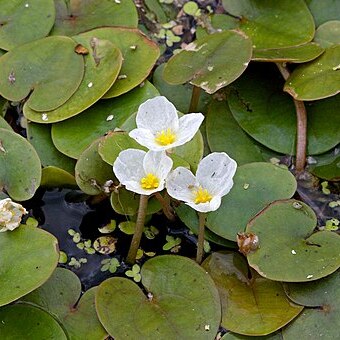Plants perennial, of fresh waters. Rhizomes absent; stolons present. Stems floating on or suspended in water, rooted or not, unbranched, short. Leaves basal, emergent or floating, petiolate; blade cordate to reniform or orbiculate, base reniform or cordate, apex obtuse to almost truncate; midvein without rows of lacunae along sides, uniform in color throughout, abaxial surface without prickles, smooth on emergent leaves or with aerenchymous tissue on floating leaves; intravaginal squamules entire. Inflorescences 1-flowered or cymose, sessile or short-pedunculate; spathe not winged. Flowers unisexual, staminate and pistillate on different plants [on same plants], emersed, pedicellate; petals white to pinkish. Staminate flowers: filaments distinct or basally connate, distinct portion longer than connate; anthers oval; pollen in monads. Pistillate flowers: ovary 1-locular; styles 6, 2-fid less than ½ length. Fruits spheric, smooth to ridged, dehiscing irregularly. Seeds ellipsoid, minutely tuberculate or muricate.
Freshwater, monoecious or sometimes appearing dioecious, perennial, attached and emergent, with axillary stolons. Leaves emergent and/or floating, usually growing as tufts or rosettes on nodes of stolons, differentiated into blade and petiole, with 1 or 2 membranous stipules at base of petiole. Inflorescences emergent, developing among leaves at nodes, unisexual, the flowers at any one node of one sex. Flowers with perianth in 2 whorls, the inner larger, petaloid, white. Male flowers 1–4 per spathe, shortly pedicellate; stamens 12, usually with some of these as staminodes. Female flowers solitary, spatheate, pedicellate; staminodes 6; ovary unilocular; styles 6, each bifid. Fruit berry-like, dehiscing irregularly. Seeds numerous.
Herbs, floating. Stems short, stoloniferous. Leaves basal, floating or submerged, rarely emerged, petiolate and stipulate; blade ovate, orbicular, or reniform, entire, with more than 5 curved veins, sometimes with a central pad of spongy tissue on abaxial surface of floating blade. Plants monoecious; flowers unisexual. Spathes 1-or 2-valved, male spathes pedunculate, 1-6-flowered; female spathes sessile, 1-flowered. Sepals greenish white. Petals white or yellowish, much larger than sepals. Stamens 6-12; anthers 2-thecous. Ovary elliptic; ovules numerous; styles 6, bifid. Fruit with 6 ribs, irregularly dehiscent at apex. Seeds ellipsoid.
Pet broadly obovate, more than 1.5 times as long as the sep; stamens in 4 alternating trimerous whorls (those of the innermost antepetalous whorl staminodial), their filaments connate in pairs below, forming 6 radial pairs; styles usually 6, flat, bifid up to half-length; stipules (1 or) 2, mostly lateral and free from the petiole; roots unbranched; otherwise much like Limnobium. 3, Old World.

